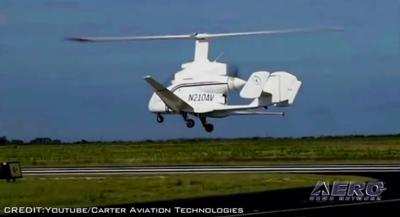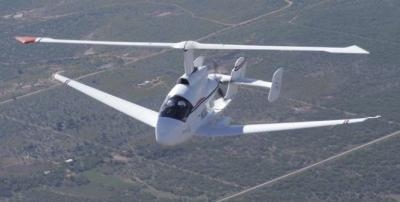Tue, Sep 15, 2015
Presentation Made At European Rotorcraft Forum In Europe
Carter Aviation Technologies last week made a presentation to the European Rotorcraft Forum in Munich Germany.

The European Union has been working on a program called Clean Sky for several years. This program seeks to improve environmental aspects of air transportation with reductions in CO2 emissions and noise pollution among the objectives. Recently, Clean Sky 2 was initiated with a consortium of participates, a multi-year plan, and a budget of around €4 billion between the European Union and industrial partners. Some of the loftier goals are a 20%-30% reduction in CO2 emissions and noise pollution with a 2014 technology baseline.
“I think we surprised a lot of folks in Munich. They’re workin a multi-year plan to create more environmentally-friendly aircraft and here we sit at Carter with a technology that achieves a reduction in CO2 between 66% [hovering aircraft] and 80% [jump takeoff aircraft],” expounded Jay Carter. “Our presentation created quite the buzz and we expect to be expanding our list of parties interested in learning more about our technology.” Carter’s Personal Air Vehicle or PAV pictured above has achieved an L/D of 11 and the potential to design an aircraft for an L/D of 16 is possible. The reduction in rotor drag achieved with the dramatic slowing of the rotor from a nominal takeoff maximum of 400 rpm to a cruise flight rotation of 100 rpm enables this level of cruise efficiency.

The idea of slowing the rotor down in flight is not new. In the 1930’s, aerodynamicists looking to improve upon autogyro efficiency recognized that if the rotor could be slowed down and kept stable, fantastic rotorcraft performance could be achieved in cruise. In the late ‘50s and early ‘60s, both the US and British governments spent years and millions of dollars trying to significantly slow the rotor. They had some success, but because
of noise, vibration, stability, and control issues, it was concluded to be either impossible or impractical. “We have been working the slowed rotor program for 21 years. It took 11 years before we first achieved an advance ratio of one. We had to identify and solve 10 issues to safely slow the rotor – the subject of 22 patents and 6 pending,” stated Jay Carter. The Carter presentation in Munich discussed those issues and the performance results from flight testing that have exceeded the emission and noise goals of Clean Sky 2.
(Images from file)
More News
With Testing Soon Complete, Launch Preparations Begin in Earnest Sierra Space's Dream Chaser has been put through the wringer at NASA's Glenn Armstrong Test Facility in Ohio, but w>[...]
Takeoff Roll The process whereby an aircraft is aligned with the runway centerline and the aircraft is moving with the intent to take off. For helicopters, this pertains to the act>[...]
“We’re proud of the hard work that went into receiving this validation, and it will be a welcome relief to our customers in the European Union. We couldn’t be mor>[...]
"Aircraft Spruce is pleased to announce the acquisition of the parts distribution operations of Wag-Aero. Wag-Aero was founded in the 1960’s by Dick and Bobbie Wagner in the >[...]
IDENT Feature The special feature in the Air Traffic Control Radar Beacon System (ATCRBS) equipment. It is used to immediately distinguish one displayed beacon target from other be>[...]
 Sierra Space Repositions Dream Chaser for First Mission
Sierra Space Repositions Dream Chaser for First Mission ANN's Daily Aero-Term (05.10.24): Takeoff Roll
ANN's Daily Aero-Term (05.10.24): Takeoff Roll Aero-News: Quote of the Day (05.10.24)
Aero-News: Quote of the Day (05.10.24) Aero-News: Quote of the Day (05.11.24)
Aero-News: Quote of the Day (05.11.24) ANN's Daily Aero-Term (05.11.24): IDENT Feature
ANN's Daily Aero-Term (05.11.24): IDENT Feature




